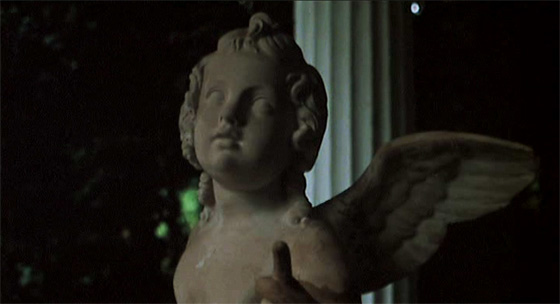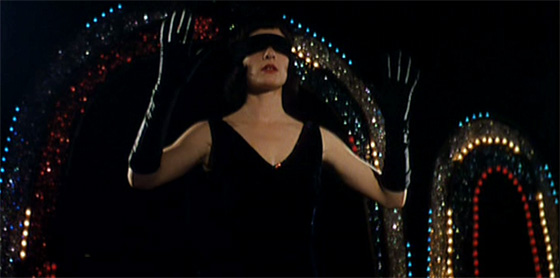
It is strange that in the age of Blu-Ray, when Criterion is casually issuing obscure art house films in high definition and Warner Bros. is scouring their archives and releasing a half-dozen cult (or never-became-cult) films every week on burn-on-demand DVDs, we still have precious little of Jacques Rivette’s filmography available in Region 1. The French New Wave’s most underappreciated director, Rivette is best known for two films, the little-seen but notorious 773-minute film Out 1 (1971), and the elliptical fantasy Celine and Julie Go Boating (1974). His films are almost all of a piece: literary, theatrical (the theater, circuses, and magic shows all recur in his work), surreal, and, frequently, very long. Love on the Ground (1983) acts as a pseudo-sequel to Celine and Julie, again pairing two female friends, who behave like twins, and thrusting them into a mystery and a haunted house. Only this time those latter elements seem less critical, stylistic dressing that only adds to the playfulness of the tangled narrative.
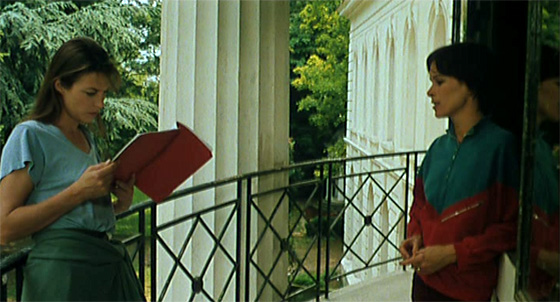
Emily (Jane Birkin) and Charlotte (Geraldine Chaplin) rehearse their performance, which is still being written.
See if you can follow: Charlotte (Geraldine Chaplin) and Emily (Jane Birkin) are actresses partaking in an experimental theater which takes place in an apartment; the audience becomes voyeurs walking from one room to the next as they follow the action. One of the guests to the performance is a writer, Clement (Jean-Pierre Kalfon), who recognizes that the play is a bastardization of his own work (the man who stole the play, Silvano, is also one of the actors). Rather than taking offense, or suing them, Clement invites the three actors to his secluded estate to act in his own new play, which he would like to produce in a similarly interactive fashion, with his entire mansion becoming the theater. The only other occupants of the home are his servant, Virgil (Laszlo Szabo), who in his spare time is “translating Hamlet into Finnish,” and the stage magician Paul (Andre Dussollier). Charlotte, Emily, and Silvano are assigned roles: Silvano is the tempestuous playwright, Emily is “Pierre,” and Charlotte is the hotly-desired woman over whom they duel, Barbara. Yet soon it becomes apparent that another artistic theft has taken place. The play is actually closely based on recent events in the life of the magician, Paul, whose ex-lover Beatrice was also pursued by Clement. To complicate matters even further, when Paul takes a lover, that woman has visions which subsequently come true. Emily takes up with Paul, and sees a vision of herself, apparently dead, lying on the floor with blood upon her brow, an unfamiliar woman in a red dress leaning over her. It doesn’t help matters that the estate is apparently haunted, or at least has strange properties: a secret, locked room emits strange sounds (jungle wildlife, or waves washing upon a beach), and glimpsing down a dark corridor might suddenly reveal strange sights.
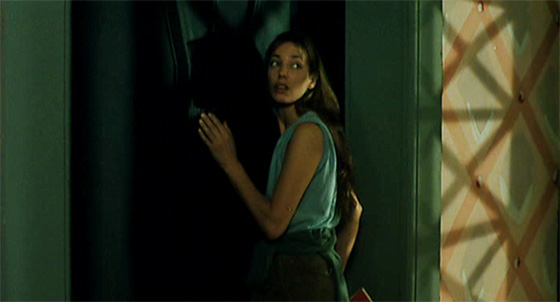
Emily hears ocean waves through a sealed door in the mysterious chateau.
The languidly-paced film (almost all of Rivette’s films are paced to mimic the realistic rhythms of everyday life) takes place over the course of a week, as the unlikely troupe rehearses, rewrites, and prepares for the big performance – all while Clement refuses to write the final act, waiting for inspiration to strike. Love affairs begin and end, taking different shapes and interweaving in complicated patterns. Mysteries are launched – (What is Virgil writing? What is in the locked room? What happened to Beatrice? etc.) – and many of them go unanswered. Late in the film, Charlotte says to Emily, “It seems like we’ve been here forever,” and indeed that’s the feeling Rivette intends to invoke. He creates a continuum into which the viewer is thrust, and sets cycles spinning kaleidoscopically, so that events seem to recur in different colors, though not exactly in a linear progression. Unlike his more famous contemporaries, Godard and Truffaut, Rivette is not the most stylish or cinematic of directors. There is no score on the soundtrack, and he doesn’t want to distract with camera tricks or flashy compositions or editing (although his languorous camera tracking always manages to find the perfect way to frame his cast of characters, theatrically embracing as many bodies in the mise-en-scène as he can). His method, as far as filmmaking goes, is to strip the film down to its barest essentials, while drawing the viewer’s attention to the artifice of the production. Perhaps the key visual moments in Love on the Ground are those at the beginning and end of the film, when spectators frame the action at the edges of the screen, leaning around corners and into doorways to watch the players. Rivette is more interested in thematic resonances of a literary level; indeed, his films might be more suited to novel-readers – or to devotees of avant-garde theater – than to film buffs. You need to be able to appreciate that not only are we watching spectators watching a play – but that those characters are in turn based on other characters, who are, in turn, watching themselves represented in the play. It’s as though two mirrors have been turned to face each other, forming a reflection that repeats infinitely onward. (Early in the film, someone even comments that Clement’s house is like a mirror, shortly before Charlotte sees an alternate-reality version of herself reflected down a hallway.)
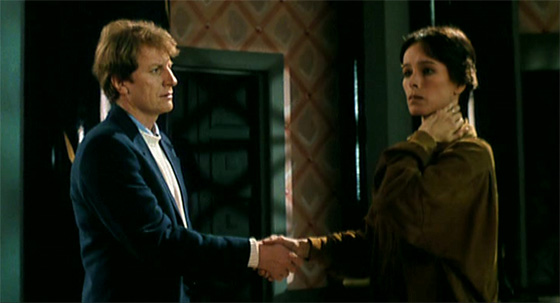
Clement (Jean-Pierre Kalfon) welcomes Charlotte, who glimpses an eerie vision of herself standing in an adjacent room.
Love on the Ground is currently available on a U.K. Region Free DVD from Bluebell Films, with English subtitles. It is advertised as the “newly restored and remastered director’s cut.” It did seem to feature scenes that I didn’t recall from a Rivette revival at the University of Wisconsin’s Cinematheque a couple years ago, although the IMDB implies that the “cut” version is 125 minutes, and I’m pretty sure that the print I watched was closer to 2 1/2 hours. At any rate, the DVD is the full 169-minute version. There are no extras – not even a chapter menu – and the picture quality is adequate, though much better than the pink-hued old print I’d watched. I recommend it highly as one of Rivette’s most elaborately-constructed, intellectually entertaining puzzle-boxes.
This review originally appeared, in slightly altered form, on my old blog Kill the Snark in 2008.
